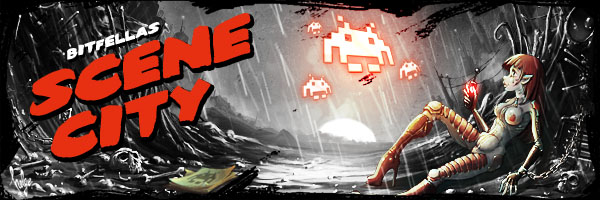Book review:
"Kunst, Code und Maschine"
Written by Adok
"Kunst, Code und Maschine - Die Ästhetik der Computer- Demoszene" (Art, Code and Machine - The Aesthetics of the Computer Demoscene) is a new book written by Daniel Botz, published by transcript. Released in summer 2011, this book is based on Daniel Botz's PhD thesis at the Ludwig Maximilians University of Munich. In 428 pages the reader mostly learns about the history of the demoscene from 1985 to 2008 on the three major platforms, C64, Amiga and PC. The historical part occupies more than half of the book and is followed by a discussion of strategies that are involved in the creation of demos, such as realtime animation and small code, from a scientifc point of view. The author studied media pedagogics and is working as an associate scientist at the LMU. In the early 1990s he was active in the Amiga demoscene himself as a musician and nowadays he arranges VJ shows.
There are many interesting facts even for people who are not totally clueless about the demoscene. The history of the scene is discussed starting with the beginnings of computers (Zuse & Co.), video gaming in the late 1970s, the first home computers in the 1980s and how the cracking scene emerged. We learn in detail about the aesthetic properties of the early crack intros and then how they improved as coders discovered undocumented hardware functions and tricks to make things possible that seemed impossible on the specific platform before, such as displaying graphics in the border of the C64 screen. Furthermore, we learn that the early demogroups on all of the three platforms did not have graphics artists yet and therefore fully relied on code, and ripped the music from existing computer games.
Then we are told about Compunet, a kind of precursor of the Internet, onto which creative people uploaded their stuff and in which way graphicians spread their work, which was ultimately used in demos. This was how the visual properties of demos became more extravagant and appealing. The author included a lot of greyscale screenshots of significant demos, especially such that served as pioneers of new techniques, and described them in such a way that the reader would be able to imagine what these demos were like even without watching them. One demo, the Redsector Megademo, even received a chapter of its own with a very detailed description. It was the demo that made the author get interested in the demoscene himself.
We learn about the history of the Amiga, how crackers and demos emerged on this platform, how early chronists of the
scene dismissed the Amiga because of its technological superiority which made demo coding far easier than on the C64, and how demos on that platform evolved from single-file demos over multipart megademos with loader screens to modern trackmos, with design becoming more and more important than just pure code. The extensive description of the history of the scene is spiced with quotations from diskmag articles as well as forum postings, and as we can see from the reference list in the appendix it was mostly Amiga diskmags such as R.A.W and R.O.M which were cited. Hugi gets mentioned three times, while Pain does not serve as a source, but the book contains a screenshot of one of its issues. Unlike Tomcat's book FREAX, this book is only about demos and intros, and not about the magazines of the scene; the magazines only serve as a source of statements from sceners.
The book then tells the story of the emerging PC platform which became technologically superior to the Amiga in the course of the 1990s and thus ultimately became the leading platform. While the early 1990s saw the advent of 3D graphics on the Amiga, it was the PC that finally ignited the switch of focus of demos from 2D to 3D. The release of Second Reality initiated the dominance of the PC platform. We then learn about how Amiga sceners reacted, copying PC effects as well as focusing on design, which was their specific strength, and how this also influenced the previously dormant C64 scene. While 3D had seemed to be impossible on the C64 for a long time, demogroups started implementing 3D effects on it using a low resolution, and after a while things were to be seen on the C64 nobody would have imagined before. Finally, the PC demos of Andromeda Software Development were considered the beginning of a new era in which demos would no longer just be effect shows, but artworks creating a special atmosphere using combinations of many effects at the same time.
I cannot but stress that the description of the history is really detailed and when reading it, I sometimes had a feeling of finally understanding things I had not understood before: The structure of the history of demos can be easily perceived with this book, and the reader realizes that there have always been groups setting new trends, which were then copied by the other groups. Basically the book shows that the evolution of demos is an evolution of code and graphics, which evolved independently, sometimes one component dominating in products and sometimes the other. I can only recommend this book to anybody remotely interested in the materia who is able to read German.
For ordering information, check out the website of Daniel Botz. A large part of the book can even be read online.
Adok
BitJam
Search BitFellas
Scene City

content search
breadcrumb
Please log in to post comments, if you are not registered please sign up now
Render time: 0.2401 sec, 0.1791 of that for queries. DB queries: 90. Memory Usage: 1,122kb



